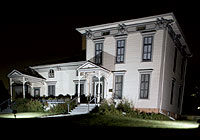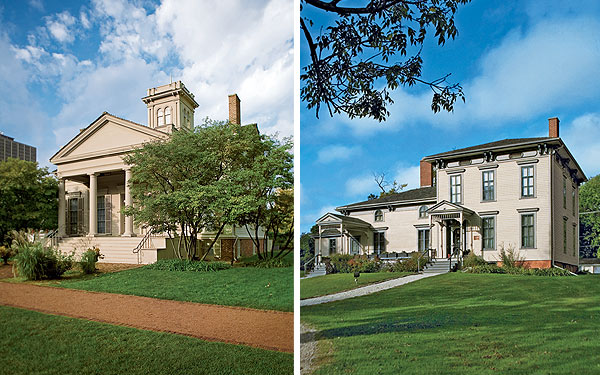
Dueling domiciles: Since 1836, the peripatetic Henry B. Clarke House (left) has settled in at three different addresses. The Noble-Seymour-Crippen House (right) comprises the original 1833 farmhouse on the south (far left) and the two-story 1868 Italianate addition on the north.
In December 1977, while riding an elevated train toward the South Side, Edward Maldonado encountered a strange apparition: a big white house floating in the air above 44th Street at Calumet Avenue. "It was very surreal," recalls Maldonado today.
"I didn’t know what it meant."
What it meant was that the Henry B. Clarke House, a local fixture since 1836, was on the move—again. Maldonado had happened to catch that roving residence in the midst of its second city trek, this time as it headed toward the site at 1827 South Indiana Avenue where it sits today. As for Maldonado, he has since had a chance to become better acquainted with the place, having served since 1999 as the curator of the Clarke, long considered the city’s oldest house.
But Ann Durkin Keating unequivocally challenges that claim. "The Noble-Seymour-Crippen House [in Norwood Park, on Chicago’s Northwest Side] is the oldest extant house in the city of Chicago," insists Keating, an editor of The Encyclopedia of Chicago and a professor of history at Naperville’s North Central College.
At the most basic level, there would appear to be no contest. Mark Noble, an English immigrant, built his farmhouse in 1833 (today the house is at 5624 North Newark Avenue). Henry B. Clarke, who had traveled to Illinois from New York State, didn’t begin work on his house (in what would today be the 1600 block of South Michigan Avenue) until 1836, three years later. So how can there be any dispute?
Members of the Clarke camp base their claim on several things. Neither house, when built, was within the limits of the town of Chicago, but the Clarke property became part of the city when it was incorporated in 1837. Chicago did not annex the village of Norwood Park until 1893. That 56-year difference is crucial—"I feel we got there first," says Maldonado—as are Clarke’s and Noble’s motives in building their homes. The rurally inclined Noble, says Maldonado, came to Illinois to establish a 150-acre farm. "The Clarkes were pioneers who had come here to help establish a city," he says.
What’s more, adds Maldonado, when you look at the Clarke house today, you see the house its builder envisioned. Though Clarke died from cholera in 1849, his wife, Caroline, added the final touches to their home a few years later—in the process providing the place with its unofficial moniker: the Widow Clarke House. Visitors to the house today are essentially stepping into the same residence that existed in the 1850s.
The Norwood Park house, on the other hand, is far different from the home Mark Noble built. Following Noble’s death in 1839, the place went through several owners before Thomas Hartley Seymour, a member of the Chicago Board of Trade, bought it in 1868. Seymour modernized the house with a stylish, two-story Italianate addition, and it is this new wing, says Maldonado, that today gives the place its "standup identity." Without question the house is a city treasure, but it’s not the house Noble knew. (Even its current interior evokes a much later era, the 1920s, when Stuart Crippen and his family lived there.) Advantage: Clarke.
Photography: Nathan Kirkman
In December 1977, Annette Barbier, currently the chairperson of interactive arts and media at Columbia College, documented the move of the Clarke house to Indiana Avenue. This is her 30-year-old video of that event.
Not so fast, says Judy Rustemeyer, the president of the Norwood Park Historical Society, which bought the Noble-Seymour-Crippen House for $285,000 in 1987. Not only is the society’s house indisputably older, she says, but "the Clarke house is not even on its original foundation." In fact, it’s not even on its second foundation—which makes for a wonderful story, even if it does undercut the claims of Clarke partisans.
In 1872, the children of Henry and Caroline Clarke sold their family’s house to John Chrimes; worried about whether another horrific fire might ravage the city (as one had in October 1871), Chrimes moved the house to a more remote locale at 45th Street and Wabash Avenue. In 1941, his grandchildren sold the place to a young African American minister named Louis Henry Ford, who used it as a family home and as a parish center for his St. Paul Church of God in Christ. (The Bishop Ford Freeway honors the memory of this crusading cleric, who died in 1995.) Thirty-six years later, looking to expand his church and worried that he didn’t have the resources to maintain a historic landmark, Ford sold the house to the City of Chicago, which decided to move it to Indiana Avenue near the recently created Prairie Avenue Historic District.
Things got off to a smooth start as the house was partially dismantled and carried by a 64-wheel truck up Wabash to the elevated tracks on 44th Street (between Prairie and Calumet avenues). Around 2 a.m. on Sunday, December 4, 1977, after power had been shut down on the el, workers used a winch to pull the 120-ton house across the tracks. There it sat, safely perched on the other side, when a severe winter front moved suddenly into the city, freezing the jacks that were meant to lower the house 22 feet to the ground. It hung there for two weeks until the temperature warmed up enough to thaw out the hydraulic equipment.
On December 18th, the house continued its slow journey to its new home, traveling by truck up King Drive to 31st Street, then west to Michigan Avenue, where it headed north again. Before crossing over the bridge above the Stevenson Expressway, the truck added another 64 wheels (so as to distribute the weight more evenly) and then moved on to Indiana Avenue, where the house settled into what is presumably its final resting place.
These, then, are the essential arguments on either side. With that information (and with the additional evidence in the timeline above), people can form their own opinions as to whether Clarke or Crippen is champ. As for Maldonado and Rustemeyer, they ultimately prefer not to enter the fray. "It seems to me [the argument] can go back and forth," says Maldonado. "I’m not convinced one way or the other." And Rustemeyer? "For me, the important thing is that we saved [the Noble-Seymour-Crippen House] from the wrecking ball."
So let’s give the last word to the historian Ann Keating. "We have very few examples of 1830s buildings in the region," she says, "so we are lucky to have these two"—a judgment that should bridge the divide between this pair of houses.
* * *
In addition to being significant local landmarks, the Henry B. Clarke House and the Noble-Seymour-Crippen House are both museums. Go to their Web sites for information about museum hours and about special tours during the holiday season: the Crippen and five other Norwood Park houses on December 1st (norwoodparkhistoricalsociety.org) and the Clarke and John J. Glessner houses on December 8th and 9th (clarkehousemuseum.org).
Photography: Nathan Kirkman
TIMELINE
|
THE NOBLE-SYMOUR-CRIPPEN HOUSE
|
THE HENRY B. CLARKE HOUSE
|
|
|
1833 A noble home Using boards cut at his son’s Des Plaines River sawmill, Mark Noble builds a one-story frame house on his 150-acre farm, 13 miles northwest of the newly incorporated town of Chicago.
|
1836 Clarke in metropolis New York transplant Henry B. Clarke begins building a house on 20 acres just south of the town of Chicago, which incorporates as a city a year later.
|
|
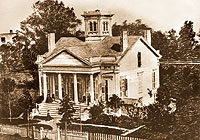 |
<< |
1849 Widow’s peak After Clarke dies during a cholera epidemic, his wife, Caroline, sells half their land to finish construction on the house (shown here in a daguerreotype from the 1850s). |
|
1868 Gentleman farmer Thomas Hartley Seymour builds a two-story Italianate addition; he raises cattle and cultivates a vineyard and apple and cherry orchards. |
>> |
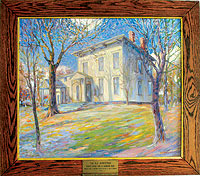 |
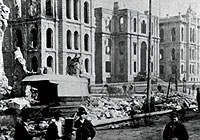 |
<< |
1872 Flameout A year after fire ravages much of Chicago, John Chrimes moves the residence four miles south to what he hopes is a safer and healthier locale. |
|
1893 Land grab Chicago annexes the village of Norwood Park, where the house stands. |
|
|
|
1920 Brightly flushed Stuart and Charlotte Crippen—respectively a concert pianist and a dramatist who had met on the Chautauqua circuit—add electricity and indoor plumbing to the house. |
 |
|
|
1926 Stuart Crippen Jr. marries Agnes Crego, as shown in a picture from the scrapbook of his sister, Margaret (third from right). |
>> | |
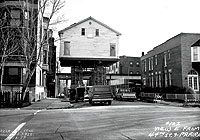 |
1941 Heaven sent Louis Henry Ford, remembered today as a civil-rights activist and the presiding bishop of the Church of God in Christ, acquires the house. |
|
| << |
1977 Moving day After removing its cupola and dormers, workers transport the house to Indiana Avenue, en route lifting it over the el. |
|
|
1987 Past preservers The Norwood Park Historical Society buys the house and the remaining 1.7 acres of land from Agnes Crego Crippen for $285,000. |
|
|
|
1988 Enter the archive The restored Noble-Seymour-Crippen House opens as a museum of the neighborhood’s history. |
>> | |
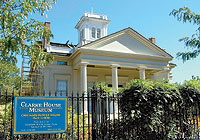 |
<< |
2004 House of many colors The white house gets a west-facing portico (likely part of the original home) and a coat of sandstone-colored paint. |



